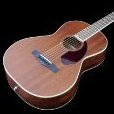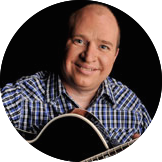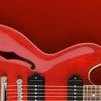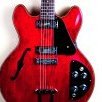-
Posts
394 -
Joined
-
Last visited
-
Days Won
102
Content Type
Profiles
Forums
Gallery
Events
Articles
Blogs
Downloads
Community Map
Posts posted by Wim VD1
-
-
-
9 hours ago, Nutty 1 said:
Beautifully played Wim, very atmospheric!😎👏🏼👏🏼👏🏼
Thanks, Mandy.
-
I like the spooky tremolo sound in Nancy Sinatra's "Bang Bang".
I'm not very familiar with minor chord progressions, and this is an interesting one starting from Fm.
Wim.
-
 5
5
-
 1
1
-
-
Funny version, @Nutty 1. And scary Frank Zappa looks.
Wim.
-
 1
1
-
-
Thanks @NeilES335.
I started to check out the first episodes this week, and learned several new things.
Wim.
-
 1
1
-
-
Well done, Kevin. You have developed a very nice and recognizable sound in your recordings.
Wim.
-
 1
1
-
-
16 hours ago, RNBACADEMY said:
Hello,
New guy on the block. Let me see if I can tackle this.
It seems like you are asking a good question. "How do you start a melody in a particular key? What is the best note to begin on?" But in a sense, its a lot like asking "What's the perfect word to start a novel on?"
There is no perfect word that fits everyone. Music in a way is a language. I feel that if you learn the basics of the language, you can narrow down the choices. In a song like Happy Birthday, trial and error is one way to do that. But the first 2 notes of the melody are "pick up" notes. The song itself starts on the third note. The accent of the chord itself will be the first bar of the song. So in this instance, it's like a "run-up" to the song itself "starting".
I use this example to express that there are no right or wrong notes to start a melody on.
What I feel would help, though, is that you DO have some idea of the chord underpinnings on that. So for that, at a minimum:
1. I'd suggest being able to write out, play and absorb/memorize internally the pitch collections of the major scale. This is like language.
2. I'd suggest that at a minimum, you understand Diatonic Harmony. This is the idea that for every note of the scale you are on, there is a chord, that fits it like a group or family. There are some parameters to that, that are outside of the scope of this answer, and I don't want to get into the weeds with you on it, but if you ask everyone "What are the diatonic triads of F Major?" every correct answer would match up. So this is something that can be learned, and memorized, and in my opinion, it is essential to understanding "language" as well. For example, even if its not "Playing" you can still "hear" in your head, where the direction of the chords would be going if they were playing. This could then inform you of a possible starting melody note
3. I'd suggest you study and learn Cadences. Cadences give the direction to the resolution of a part of a progression. a V to I is a cadence, for example. You can also learn chord tendencies, like how many songs go I IV V, of vi ii V I or any number of directions.
If this is getting you a bit into the weeds, and you don't know what I just stated above, no worries. If you learn the Harmonized Major Scale, and we also call this Diatonic Harmony, and you label the order of these chords starting on the first chord of the family with Roman Numerals...
Here...I'll use the chords in the key of F Major as an example:
F Gm Am Bb C Dm Edim
The first chord is F which would be Roman Numeral I.
Gm - The next chord, or chord number 2 would be ii (MInor chords get lower case roman numerals and Major get uppercase)
Then using a vi ii V I - with F being the key, you'd have Dm Gm C and then F played in that order. This is an example of what I mean by chord directions, or tendencies which us that understand that language can identify and conceptualize and hear...again this is language, and it's learned by steps and practice and application.
So ultimately in your development as a musician that wants to understand language, you can "hear" the melody you want, and the way the chords, if they were played, where they'd be, and that might inform you as to what you want your melody to do, and/or what someone else's melody might be doing, and based off of.
Rarely is any melody written devoid of a sense of where the chords might go if they were there, is what I'm saying. Even if they aren't there, a melodies accented or emphasized notes give some sense of a place where a chord might have been placed.
I hope these thoughts, while they might not have directly answered your question, give you some idea where TO start developing your own language, so that you can answer this question, for yourself any time.
Everyone's answers definitely work, what I was thinking is that one alternative to trial and error is to have some sense of what chords might be playing in the background, even if they won't actually be there, they can still be felt.
Best,
Sean
RnB Academy
.com
Thanks for this clear explanation, Sean.
I will check out your Rock N Blues Academy.
Wim.
-
@matonanjin. I found arpeggios interesting, so I got another resource dealing with this concept (Chord Tone Soloing) and continued working on it after moving away from Session 14.
Actually, I spent several months on the topic.
Wim.
-
I just watched the first video. Clear explanation. Thanks for sharing.
Wim.
-
Interesting article. Thanks for sharing!
-
-
For this stormy season, I recorded a Stormy Monday based acoustic blues.
Wim.
-
 9
9
-
 1
1
-
-
Great to hear from you again, Danny!
-
 1
1
-
-
On 9/4/2019 at 6:04 PM, matonanjin said:
Wim, really nice. Those string bends may have been challenging but one wouldn't know it. Very tasty bends.
Thanks, Ron!
-
11 hours ago, IanD said:
@Wim VD1, I just caught up on your last two solos. These are great. The second one is particularly good, completely flawless You are doing so well.
Ian
Thanks for your nice words, Ian. I really appreciate that.
-
 1
1
-
-
Well done, Kevin. Great sound.
Wim.
-
On 8/26/2019 at 5:17 PM, gotto said:
Sounds great to me! Nice playing Wim.
Greg
Thanks, Greg.
-
This is a final solo from the Classic Rock course I just finished. It is in Angus Young style again, just like the previous one. I realize I have some work to do to improve my vibrato. String bends with vibrato on top are a real challenge.
Wim.-
 5
5
-
-
11 hours ago, Old Guy said:
It's alive!!
That's great. Looking forward to seeing and hearing the end result.
Wim.
-
 1
1
-
-
9 minutes ago, Steve Krenz said:
Yes, I would read that as a pull-off in guitar notation.
Here's the scoop...
1) Curved line (Tie) between two notes of the same pitch = A TIE that functions as a rhythmic extension of the first note to make the first note longer in duration. You'll see these on notes within the same measure and also to hold a note over the barline.
2) Curved line (Tie) between two notes of different pitches = A SLUR indicator for a wind instrument.
If you were playing a clarinet then you wouldn't re-articulate the second note.
BUT, guitar players are not wind instruments, so if we see this between two notes in a guitar piece it would indicate to use either a Hammer-On (if the second note is higher in pitch than the first note) or a Pull-Off (if the second note is lower in pitch than the first note.)
Hope this helps.
Learn all you can! - Steve
Hey Steve, could it indicate that you slide from one note to the other as well?
Wim.
-
Angus Young was the reason I bought my first electric at the age of 13. About 38 years later, I am finally able to play some solo "in the style of". Yeah, all those waisted years...
 Wim.
Wim.-
 6
6
-
-
Great job, Mandy.
I thought you did a Stevie Nicks?
Wim
-
 1
1
-
-
Great performance, Ian. Thanks for sharing your wonderful experience with us.
Wim.
-
 1
1
-
-
Still working on mastering pentatonics.
This George Harrison style solo is a great exercise on playing the major pentatonic scale all over the neck.
Thanks for listening.
Wim.-
 5
5
-






Monthly Recording Challenge 73 - Spooky, Scary or Silly 👻👀🎃
in Guitar Playing & Technique
Posted
Thanks, Ian!